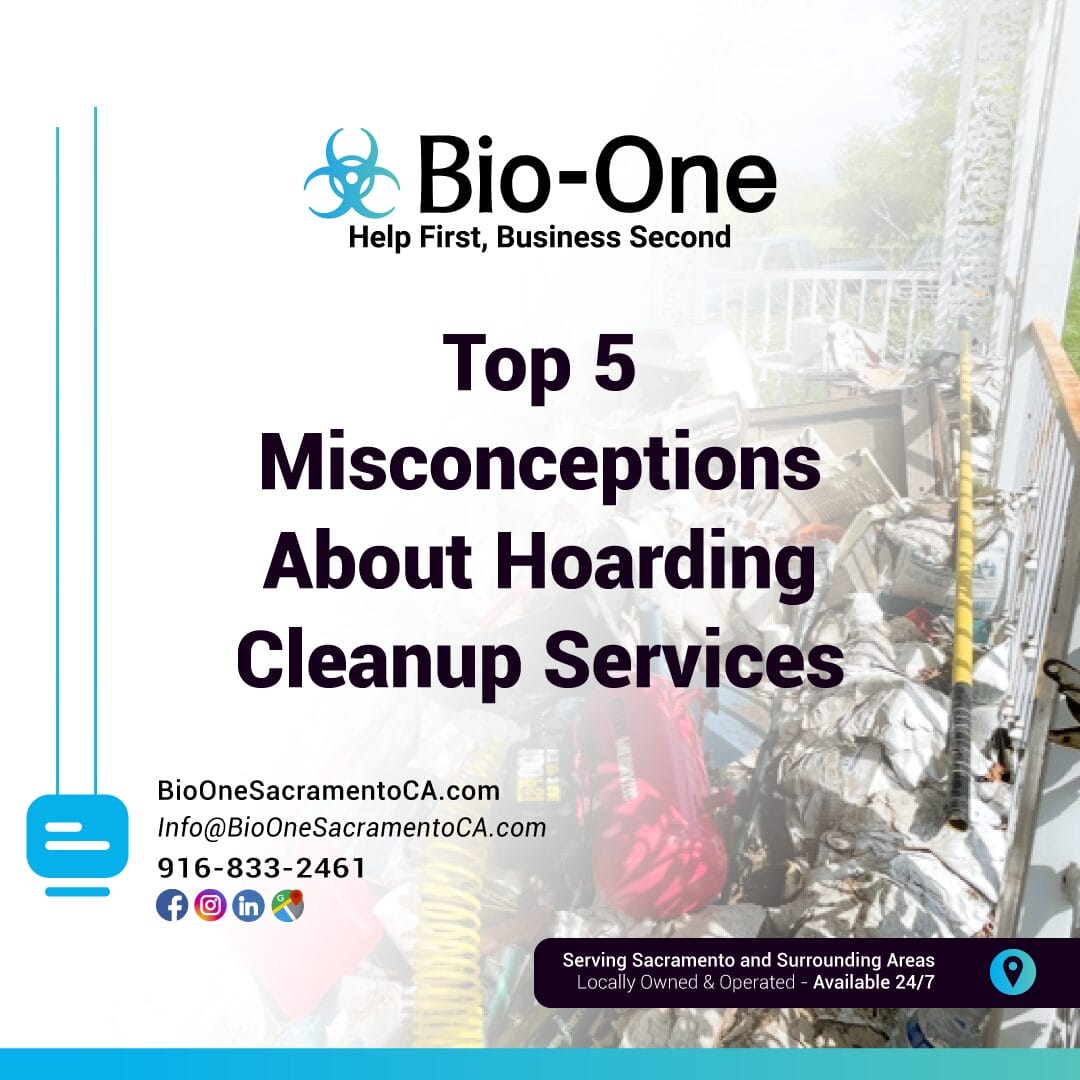
For those affected by hoarding, whether directly or indirectly, seeking help can be a challenging step. Unfortunately, misconceptions about hoarding cleanup services often prevent individuals and families from getting the support they need. At Bio-One of Sacramento, we understand how difficult it is to take that first step, and we're here to dispel harmful myths surrounding our work.
Below, we unravel five common misconceptions about hoarding cleanup services, providing clarity, compassion, and insight into how we help clients regain control of their spaces and lives.
One of the most prevalent misunderstandings about professional hoarding cleanup is that it boils down to tossing belongings into trash bags. However, hoarding cleanup is far more nuanced and thoughtful than that.
At Bio-One of Sacramento, respect for personal property and sentimental belongings is a top priority. Our team makes every effort to identify items of value, such as heirlooms, photographs, legal documents, and other sentimental possessions. Rather than indiscriminately discarding items, we collaborate with clients to make deliberate and mindful decisions about what to keep, donate, recycle, or dispose of.
Hoarding cleanup is about more than clearing clutter; it’s about creating a safer and healthier home environment while honoring the client’s emotional needs. Learn more about how we approach each cleanup with compassion and care on our homeless encampment and hoarding cleanup page.
Another harmful myth is the assumption that hoarding is a result of laziness or poor housekeeping. The truth is, hoarding is a complex mental health disorder that often stems from underlying conditions such as anxiety, obsessive-compulsive tendencies, or traumatic life events. According to the American Psychiatric Association, hoarding disorder goes beyond collecting items, featuring emotional distress about discarding possessions and a need to accumulate belongings.
A professional cleanup service not only understands the intricacies of the disorder but also prioritizes compassion in every step of the process. For example, we utilize discretion (our team often arrives in unmarked vehicles) and work collaboratively with family members, therapists, and support networks to ensure the client feels supported.
Our goal is not only to restore functionality to a living space but also to help individuals regain control of their environment without judgment.
Hoarding situations often develop over years, meaning it’s unrealistic to assume a single cleanup session can resolve deeply rooted issues. While professional cleanup services are efficient, hoarding cleanup is a step-by-step process that involves careful planning, sorting, and sanitizing. Swift, indiscriminate cleanup can overwhelm clients and even lead to relapse if underlying causes are not addressed.
At Bio-One of Sacramento, we approach each situation systematically:
At first glance, tackling a hoarding situation on your own might seem economical or manageable. However, hoarded properties often involve safety hazards such as pest infestations, mold, structural damage, and biohazards (e.g., expired food, human or animal waste). Cleaning without the proper training, tools, or safety measures can pose significant health risks.
Hoarding cleanup teams like ours are trained to handle:
Many individuals avoid seeking professional cleanup services because they fear stigma or judgment. However, reaching out for help with hoarding is an act of courage, not shame.
Hoarding affects millions of people across the country, and professional cleanup services exist to assist—not to judge. At Bio-One of Sacramento, our motto, “Help First, Business Second,” reflects our commitment to treating every client with empathy and dignity. Whether you’re calling on behalf of a loved one or seeking help for yourself, we are here to ensure you feel supported every step of the way.
Our testimonials section is filled with stories from clients who have transformed their homes and lives thanks to professional cleanup services.
Choosing the right team for hoarding cleanup is essential. At Bio-One of Sacramento, we are dedicated to providing:
Addressing a hoarding situation can feel overwhelming, but debunking these misconceptions is an important step in moving forward. By better understanding the thoughtful, respectful approach behind professional cleanup services, individuals and families can feel empowered to take action.
If you’re ready to restore health and order to your living space, reach out to Bio-One of Sacramento today. We can tackle even the most challenging situations with compassion and expertise, giving you the fresh start you deserve!
Hoarding is often more than just a collection of clutter; it’s a deeply rooted mental health challenge that can severely impact individuals and their loved ones. With risks ranging from emotional strain to serious health and safety hazards, addressing hoarding requires more than just cleaning out a space. A collaborative approach combining mental health support and professional cleanup is vital to truly tackle the issue in a holistic and sustainable way.
Mental health professionals play a key role in addressing the psychological and emotional roots of hoarding, while cleanup companies like Bio-One of Sacramento handle the physical aspects of the situation with expertise and compassion. Together, they offer individuals and families a path to recovery, safety, and a better quality of life.
Hoarding disorder is characterized by persistent difficulty discarding or parting with possessions, regardless of their actual value. This leads to an accumulation of items that congest living spaces, interfere with daily activities, and can even create dangerous conditions in the home.
While hoarding might seem like a “simple” behavioral issue, it is often linked to deeper mental health challenges. Common underlying conditions include:
Hoarding is a complex disorder, and its resolution requires more than just cleaning out a home. For lasting change, the psychological roots need to be addressed. Mental health professionals approach this through evidence-based interventions such as therapy, counseling, and skill-building.
CBT is considered the gold standard for treating hoarding disorder. Therapists help individuals identify unhelpful thoughts and beliefs about their possessions, such as “I might need this someday” or “This object gives my life meaning.” By challenging these thought patterns, the individual can begin to unlearn the compulsive behaviors that lead to hoarding.
For many hoarders, their accumulation of possessions is closely tied to emotional struggles, such as grief or unresolved trauma. Mental health professionals create a safe environment where clients can explore these feelings and develop healthier coping strategies.
Many individuals who hoard struggle with decision-making, organization, and time management. Mental health treatment often includes teaching practical skills in these areas to help clients manage their living spaces better in the long term.
Hoarding often affects more than just the individual; family members can feel helpless, frustrated, or even estranged. Therapists can work with families to improve communication, set boundaries, and foster supportive relationships that encourage recovery.
While mental health professionals work on these psychological components, the physical environment cannot be ignored. A clutter-free and safe living space is crucial for the person’s mental well-being and recovery. That’s where the expertise of Bio-One of Sacramento comes in.
While mental health professionals focus on the emotional and behavioral aspects of hoarding, Bio-One of Sacramento specializes in handling physical cleanup, ensuring a safe and sanitary environment for all involved.
Hoarding situations often involve much more than clutter. Homes may contain biohazards like mold, rodent droppings, or decayed food, all of which pose serious risks to health and safety. Bio-One of Sacramento is uniquely equipped to handle these challenges with professionalism, discretion, and respect.
Each hoarding cleanup project begins with an assessment to understand the extent of the challenge. The Bio-One team then develops a step-by-step plan to prioritize safety while making the space livable again.
Hoarding environments often harbor biohazards that require specialized equipment and protocols to safely remove. From pest infestations to potential contaminants, Bio-One ensures these hazards are eliminated thoroughly and responsibly.
Bio-One of Sacramento understands that hoarding is a sensitive issue. Their team works with compassion and empathy, avoiding judgment and focusing on solutions. This approach helps build trust with clients and families, making the process less overwhelming.
Hoarding cleanup doesn’t just aim to empty out a space; it also includes sanitizing and restoring the environment to make it safe and welcoming for those living there.
The Bio-One team is experienced in working alongside therapists, counselors, and social workers to ensure the cleanup process aligns with the emotional needs of the individual recovering from hoarding disorder. This collaboration minimizes the trauma associated with parting with possessions and helps create a smooth transition to a healthier lifestyle.
Whether you’re a family member, friend, or someone dealing with hoarding firsthand, it’s important to approach the situation with care and understanding. Here are some actionable tips for navigating the physical and emotional challenges of hoarding recovery:
Hoarding is not just about being “messy” or “lazy.” It’s a deeply rooted mental health challenge. Approach conversations with compassion and an open mind.
Mental health professionals are trained to address hoarding disorder in a way that promotes sustainable change. Encourage your loved one to seek therapy and support.
Cleaning up a hoarded space is overwhelming and potentially dangerous without the proper training. Enlist professionals like Bio-One of Sacramento who have the tools and expertise to handle the job safely and effectively.
Foster a collaborative relationship between therapists, cleanup crews, and family members. This team approach ensures that both the mental and physical aspects of hoarding are addressed thoroughly.
For individuals struggling with hoarding, starting small can reduce overwhelm. Focus on one area or category of items at a time, and celebrate progress along the way. Having professionals on hand can make the process more manageable.
Hoarding recovery is not a one-step process; it’s a journey that requires addressing both the mental and physical impact of the disorder. Mental health professionals provide the emotional support and tools needed to tackle the behavioral roots, while Bio-One of Sacramento ensures a safe, clean, and livable physical environment.
If you or a loved one are struggling with hoarding, don’t hesitate to reach out for help. Whether it’s through therapy, cleanup services, or a combination of both, taking that first step paves the way for a healthier future.

When you hear the term “crime scene cleanup,” your mind might immediately jump to scenes from TV dramas or movies. A team sweeps in with gloves and masks, cleans up in a matter of minutes, and disappears into the night, leaving nothing but a spotless space. While that might make for great entertainment, the reality of crime scene cleanup is far different. Misunderstandings surrounding this field are common, and they can lead to confusion and even unsafe situations.
At Bio-One of Sacramento, we’ve encountered plenty of misconceptions about our profession, and today, we want to set the record straight. Here are the top five myths about crime scene cleanup, debunked.
A common belief is that after law enforcement investigates a crime, they also handle the cleanup. This is not true. Police officers, detectives, or coroners are responsible for collecting evidence and ensuring all investigative procedures are conducted—but that’s where their job ends.
The cleanup is left to property owners, families, or, ideally, a professional biohazard cleanup service like Bio-One of Sacramento. Crime scenes often involve dangerous materials like blood, bodily fluids, or biohazards that pose serious health risks. Cleaning these up requires specialized training, equipment, and licensing to ensure safety and compliance with local regulations.
The truth? Crime scene cleanup is a responsibility best left to trained professionals with the expertise to handle it both safely and effectively.
TV might give the impression that cleaning up a crime scene is a fast and simple process, but this couldn’t be further from the truth. Crime scenes often involve complex and hazardous conditions. Blood and bodily fluids can seep into floors, walls, and furniture, requiring extensive remediation to ensure contaminants are fully removed. Odors can linger, making thorough deodorization a crucial step.
On top of that, there are emotional and psychological factors in play. Families or property owners may be grieving or in shock, making the presence of compassionate, experienced cleanup technicians essential.
The truth? Crime scene cleanup is a meticulous process. It involves careful planning, specialized cleaning solutions, professional-grade equipment, and extensive safety measures to restore the space to a safe and livable condition.
The idea of saving money by tackling a crime scene cleanup on your own can be tempting, but it’s not just about scrubbing away stains. Without the right training and equipment, attempting to clean a scene yourself puts both your health and your property’s safety at risk.
For instance, biohazardous materials like blood or bodily fluids can contain pathogens like hepatitis or HIV. Without proper handling and disposal methods, the contamination risk is significant. Additionally, many states have strict regulations about how biohazards should be handled and disposed of, and failing to follow these can result in legal troubles.
The truth? Professional biohazard cleanup services, like those provided by Bio-One of Sacramento, protect you from danger and ensure the scene is restored in compliance with legal and safety standards.
When people think about crime scene cleanup, they tend to focus on the physical act of cleaning. But the role of professionals extends far beyond that. At Bio-One, we understand the emotional toll a traumatic event can take, and we approach every job with compassion and discretion.
Our team works closely with families, property managers, and law enforcement to ensure the process is as stress-free as possible. We show respect for personal belongings, work discreetly with unmarked vehicles, and prioritize communication throughout the process.
The truth? Crime scene cleanup isn’t just about cleaning; it’s about restoring both physical spaces and peace of mind.
Sometimes, crime scenes don’t look gruesome at first glance, leading people to believe cleanup isn’t necessary. However, invisible dangers can linger. Pathogens from blood or bodily fluids aren’t always visible, and surfaces that look clean may still be contaminated.
Without proper decontamination, these issues can lead to serious health risks for anyone who enters the area. Professionals can identify and remove contaminants that might otherwise be missed and ensure the space is truly safe.
The truth? Even if the scene appears clean, professional cleanup is critical to remove health hazards and restore safety.
At Bio-One of Sacramento, we specialize in handling the toughest situations with compassion, experience, and respect. Our team is trained to safely and discreetly clean crime scenes, biohazards, hoarding situations, and more. We take the burden off your shoulders, so you can focus on healing and moving forward.
If you’re in need of professional crime scene cleanup in Sacramento or the surrounding areas, don’t wait. Contact us at 916-833-2461 or visit our website to request a service. Remember, when it comes to biohazard cleanup, it’s always better to trust the professionals. Bio-One of Sacramento is here for you, every step of the way.

Dealing with a biohazard incident in your home can feel overwhelming. From bloodborne pathogens to chemical spills, these situations pose serious health risks if not handled correctly. Knowing what steps to take—and what to avoid—is crucial for ensuring your safety and restoring your space. That’s why we’ve put together this guide to help you understand the do’s and don’ts after a biohazard incident. If you need professional help, biohazard cleanup services like those offered by Bio-One of Sacramento are the safest and most effective solution.
A biohazard incident involves biological substances that pose a threat to human health and the environment. Common examples include:
Your immediate priority is to ensure the safety of everyone in the household. If possible, evacuate the affected area and limit access to prevent potential exposure to harmful pathogens or hazards. Wear protective gear, such as gloves and a mask, to minimize contact with contaminants.
Determine the scope of the incident. Is it contained in a small area, or has it spread? For example, a chemical spill in one room is different from a hoarding situation that involves the entire house. This assessment will help you communicate effectively with cleanup professionals.
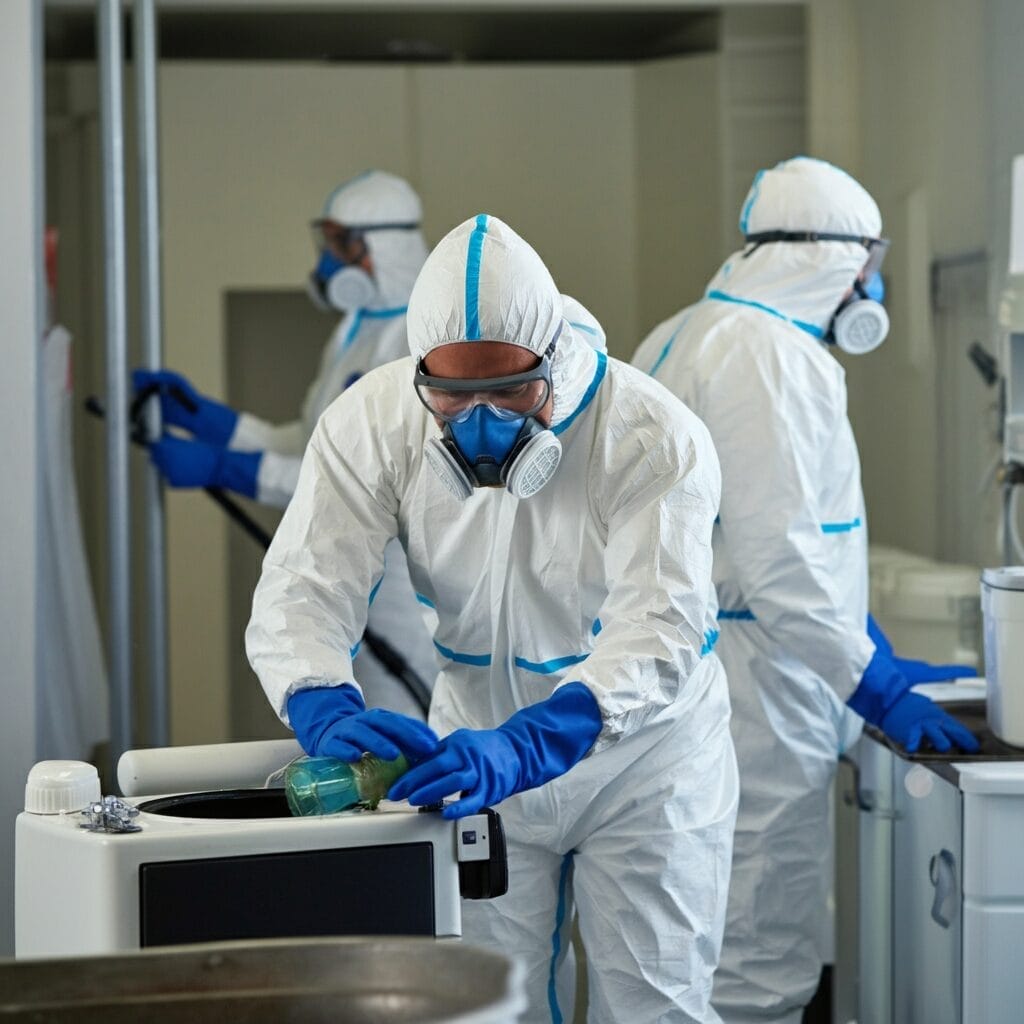
While it may be tempting to handle the cleanup yourself, biohazards require specialized training, equipment, and disposal protocols. Bio-One of Sacramento offers experienced biohazard cleanup services to safely manage and remediate potentially dangerous situations. Learn more about our services on our website.
Professionals will follow a thorough process that includes assessment, containment, cleanup, disinfection, and waste disposal. This ensures your home is restored to a safe and livable condition.
Some biohazard incidents, such as chemical spills or crime scenes, may require notification of local authorities. They may need to investigate or ensure the environment has been properly secured.
Take photos and keep detailed notes. If the incident is covered by insurance, your provider may require this documentation for claims. The professionals you hire can often assist with this process.
Cleaning up a biohazard without proper training and equipment can result in serious health risks. For example, exposure to bloodborne pathogens such as hepatitis and HIV can occur without adequate protection and protocols.
Professional cleanup teams use specialized tools and chemicals to safely handle these situations. Trying to manage it yourself might also lead to improper disposal, which can have legal implications.
Industrial-grade disinfectants are designed to eliminate pathogens effectively, while most household cleaning products may only mask the issue. Using the wrong product could spread the contamination further or damage surfaces in your home.
The longer a biohazard remains unaddressed, the greater the risk to your health and property. For example, unattended decomposition can result in harmful bacteria leaking into floors and walls, making remediation more complex and costly. Contact biohazard cleanup services promptly to mitigate risks.
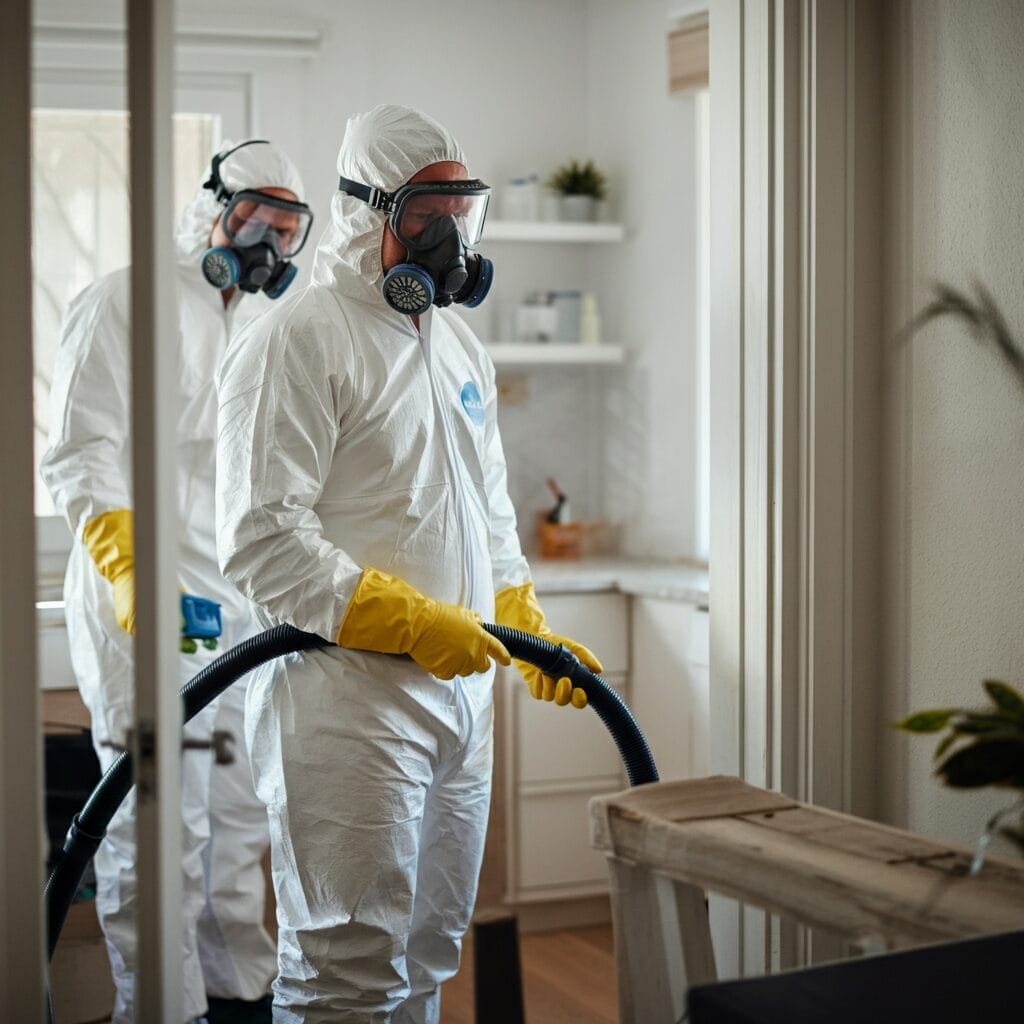
Professional biohazard cleanup teams, like those at Bio-One of Sacramento, are trained to handle hazardous materials with precision and care. Here’s why hiring experts is essential:
Dealing with a biohazard is stressful, but you don’t have to handle it alone. Follow the steps outlined above to safeguard your health and home. When in doubt, always contact experts like Bio-One of Sacramento for reliable biohazard cleanup services.
We’re here to help. Visit our website or call us today to learn more about our full range of cleanup solutions. You can count on our team to handle these situations with discretion, professionalism, and care.
A biohazard incident requires urgent attention, but navigating it doesn’t have to feel impossible. By prioritizing safety, knowing what to do, and reaching out for professional help, you can restore your home and peace of mind. Don’t hesitate to act when it comes to such serious situations. Your health and safety are worth it!
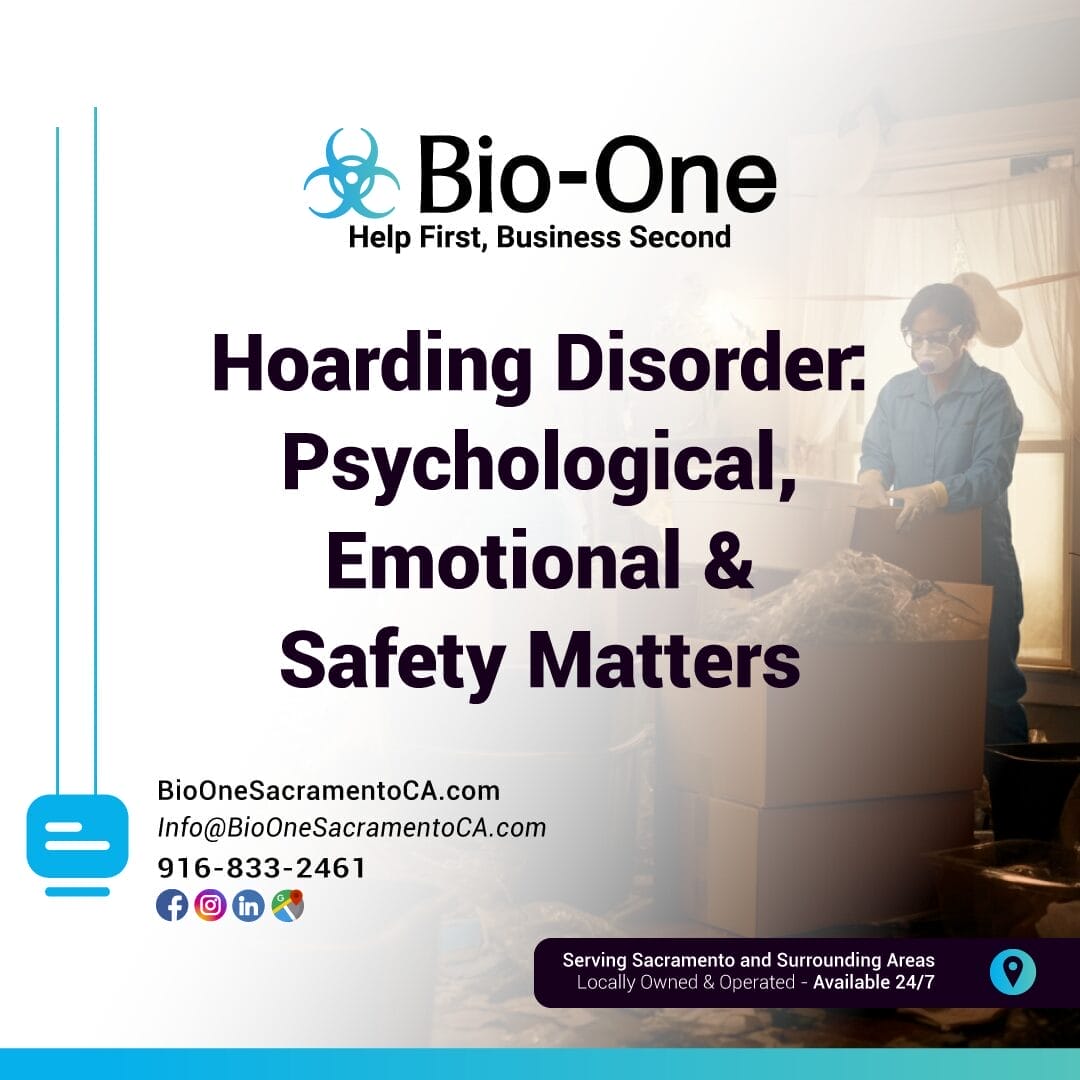
Hoarding disorder is a complex and often misunderstood condition that goes far beyond clutter or disorganization. It’s characterized by the excessive accumulation of items, difficulty discarding possessions, and significant distress or impairment as a result. For families and friends of individuals who struggle with hoarding, it can be a heartbreaking experience, even more so if they don’t know how to approach the problem effectively.
Cleaning up a hoarded home is no simple matter. Beyond the physical mess lies a web of psychological, emotional, and even safety concerns. This blog will explore the deeper aspects of hoarding, outline why safety and compassion must go hand in hand when addressing it, and provide actionable guidance on helping a loved one tackle the issue. It will also offer insight into why professional cleanup services play an essential role in achieving a resolution that’s both safe and respectful.
Hoarding is often linked to underlying mental health challenges, which makes it crucial to approach the issue with understanding and care. According to the American Psychiatric Association, hoarding disorder is often accompanied by other conditions such as anxiety, depression, or obsessive-compulsive disorder (OCD). Individuals with hoarding disorder may attach emotional value to their possessions in ways that don’t seem logical to others. For example, they might believe that these items provide a sense of safety, symbolize important memories, or could “someday” be useful.
For many, the very idea of discarding items triggers intense emotional distress. This fear often leads to avoidance, creating a cycle where the hoard only continues to grow. What might look like stubbornness or neglect to an outsider is often the result of deep emotional pain and a struggle to cope with overwhelming thoughts.
The first step in addressing a hoarding situation is understanding that the behavior isn’t laziness or defiance, but a sign of a serious underlying issue. Compassion goes a long way in helping someone feel supported rather than criticized, which is critical for encouraging change.
Aside from the emotional and psychological toll, hoarding poses serious health and safety risks both to the person struggling with the disorder and to those around them. These risks include:
Hoarded homes often become breeding grounds for mold, dust, and pest infestations, contributing to poor air quality and spreading allergens. The presence of decaying food, animal waste, or unsanitary conditions can also expose inhabitants to dangerous pathogens. For those with preexisting health conditions like asthma, the environment can be especially hazardous.
Excessive clutter increases the risk of fires. With piles of combustible material like paper and fabric blocking pathways, escape routes in the event of an emergency can be obstructed. Firefighters often face significant challenges navigating hoarded homes, putting everyone’s safety at greater risk.
The sheer weight of accumulated items can strain floors and walls, causing long-term structural damage to a home. Over time, this might result in costly repairs or even make the property unsafe to inhabit.
Narrow pathways, unstable piles, and the lack of clear walking space heighten the risk of falls and physical injuries. Seniors living in hoarded homes are especially vulnerable to these hazards.
If you have a family member or close friend struggling with hoarding, your first instinct might be to clear the clutter yourself or confront them about the mess. However, an unsympathetic or aggressive approach can backfire, leading to increased resistance and emotional harm. Here are some compassionate steps you can take:
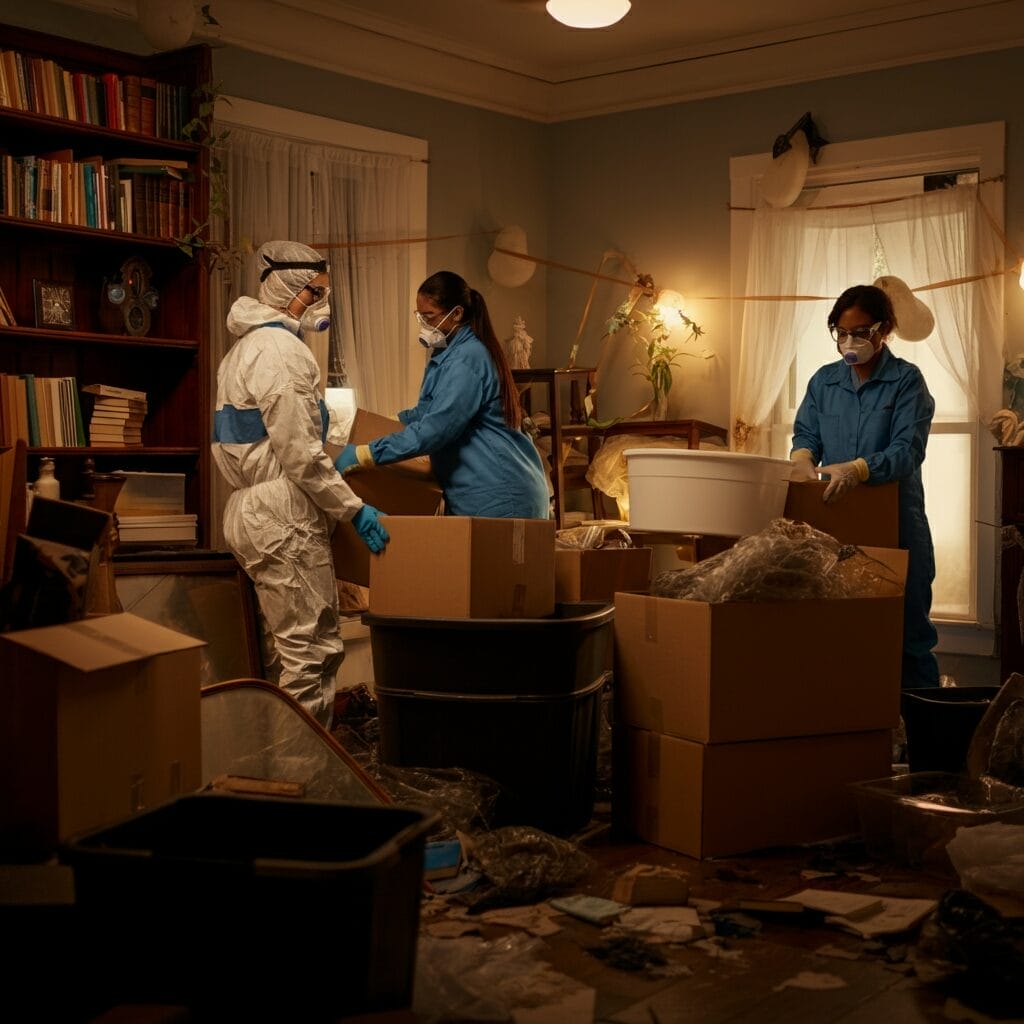
Understanding hoarding disorder can help you empathize with your loved one and recognize the challenges they face. Learning more about their emotional attachment to items can guide you in responding with patience.
Approach the topic without judgment. Use non-confrontational language and express concern for their well-being. For example, you might say, “I’ve noticed you have a lot of things in your home, and I’m worried about your safety.”
Suggest talking to a therapist or counselor who specializes in hoarding or mental health issues. Recovery from hoarding often requires professional guidance to address the underlying emotions driving the behavior.
Rather than attempting to clear out an entire home in one day, encourage your loved one to focus on manageable tasks. This could be as simple as clearing off a single table or sorting through a small box of items.
Resist the urge to throw items away on their behalf. This can feel like a violation of trust and may cause them to retreat further into their hoarding behavior. Any cleanup efforts should be done with their input and cooperation.
Change doesn’t happen overnight. Progress may be slow, and there will likely be setbacks along the way. Offer ongoing support and reassurance that they’re not alone in dealing with their challenges.
Hoarding cleanup can become overwhelming, especially in severe cases where health and safety risks are high. Professional cleanup services are often the most effective way to restore a hoarded home while minimizing emotional distress for the individual and their family.
If you or someone you care about needs assistance, consider reaching out to trained professionals who can help restore both the physical and emotional well-being of everyone involved. Together, we can handle the toughest challenges with respect and care.
For more insight into hoarding behaviors, learn about the psychological causes of hoarding and how they manifest. To understand how to approach and support a loved one, check this guide on helping someone with hoarding disorder. These resources provide valuable tools and knowledge to help manage and overcome hoarding challenges effectively.
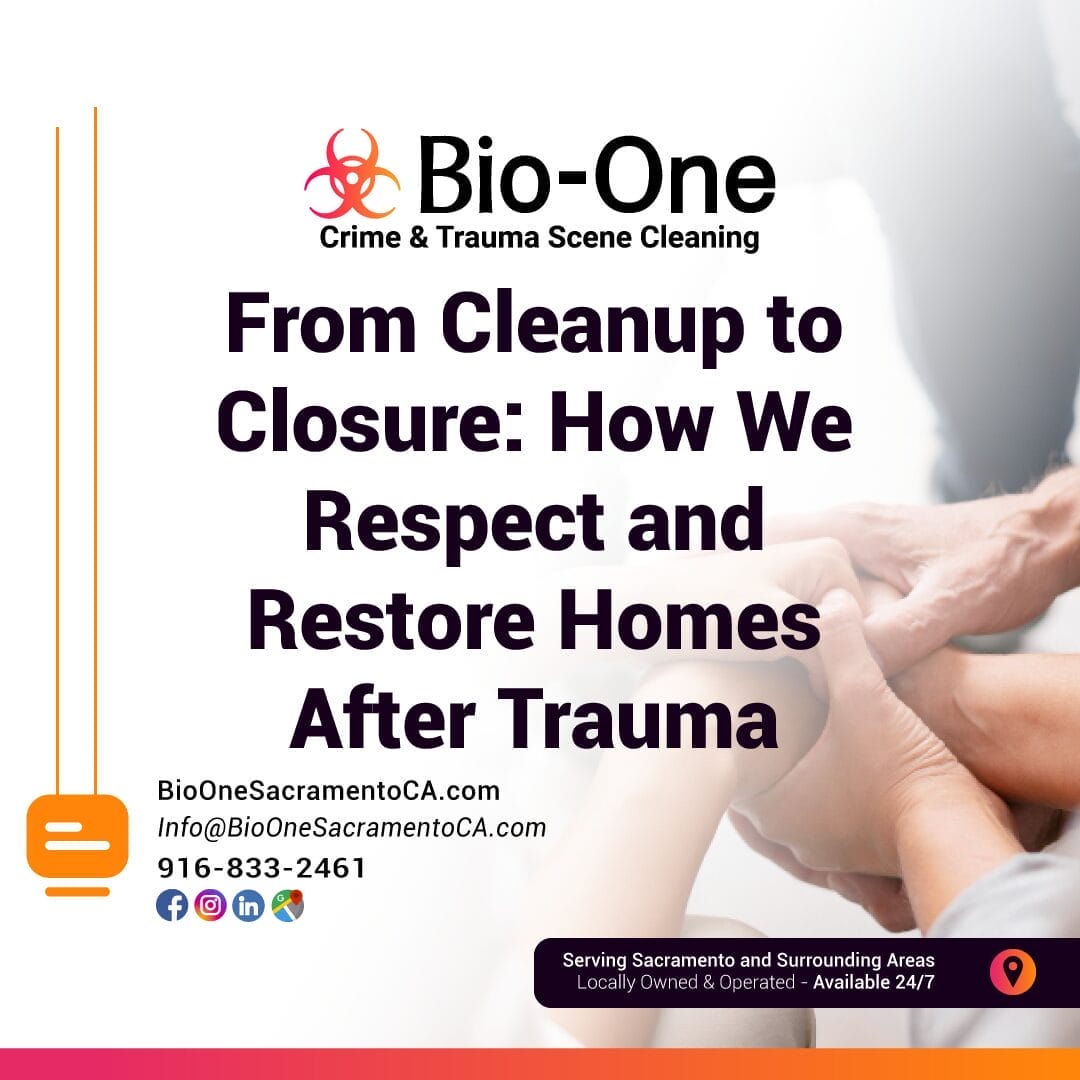
Trauma can leave more than physical damage in its wake. It can impact the very sense of safety and comfort a home should provide. At Bio-One of Sacramento, we specialize in turning these challenging times into an opportunity for healing through our expert trauma restoration services. Our goal isn’t just to clean up the physical aftermath but also to respect the emotional weight of the situation and restore the home as a place of peace and renewal.
Here, we outline how we approach trauma restoration with compassion, precision, and professionalism, guiding families and property owners from chaos to closure.
At Bio-One of Sacramento, we understand that every trauma scene is not just a job site but a deeply personal space. Whether it involves a crime scene, unattended death, or complex biohazard contamination, we ensure that our approach is rooted in empathy and respect. This starts with listening.
During our initial consultation, we take the time to understand your concerns, answer questions, and develop an action plan that prioritizes your well-being. Our team is trained to handle emotionally sensitive situations, ensuring that we work with the utmost discretion and kindness.
For those dealing with the emotional toll of trauma, additional support is invaluable. Organizations like SAMHSA’s National Helpline offer free, 24/7 assistance to connect you with mental health resources during difficult times.
Before beginning any cleanup, our trauma restoration process starts with a meticulous assessment. This step is critical not only for providing an accurate cost estimate but also for ensuring that all areas of concern are addressed. Trauma scenes often contain hidden risks like biohazard contamination, which must be identified and handled properly to prevent long-term health complications.
Our assessment includes evaluating the following:
We prioritize transparency during this stage, explaining each step of the plan to make the process as stress-free for you as possible.
Trauma restoration is not just about cleaning surfaces. At Bio-One of Sacramento, our certified professionals adhere to OSHA and CDC biohazard safety guidelines to ensure the highest levels of sanitation and disinfection.
Key elements of our process include:
By thoroughly addressing biohazards, we provide not just cleanliness but peace of mind that the space is truly safe to inhabit again.
One of the lingering challenges in trauma restoration is dealing with odors and damage caused by biohazards or accidents. Odors, particularly from decomposition or smoke, can seep into walls, fabrics, and floorboards, making professional techniques essential for complete remediation.
At Bio-One of Sacramento, our team specialists excel at odor removal and structural restoration. Using advanced technology like air scrubbers and thermal fogging, we don’t just mask odors—we eliminate them at their source. Additionally, we will address areas of structural damage, ensuring that your home is restored both visually and functionally.
Trauma restoration isn’t just about cleaning up a space; it’s about helping individuals and families find closure. To that end, we often collaborate with local mental health professionals, victim advocates, and government agencies to connect our clients with the right resources. Some helpful starting points include the American Psychological Association’s trauma resources and community victim support programs.
We also provide education to help clients maintain the restored space and prevent future issues. For instance, tips on proper cleaning practices and regular property inspections can go a long way in keeping the environment safe and welcoming.
What sets Bio-One of Sacramento apart in trauma restoration is our commitment to balancing technical expertise with human compassion. We don’t see a trauma scene as just a job; we see it as an opportunity to help individuals regain their sense of home and normalcy.
Here’s why families and property owners trust us:
Trauma restoration goes beyond physical cleanup; it’s about allowing a new chapter to begin. At Bio-One of Sacramento, we take pride in supporting families and individuals through what is often one of the most difficult periods of their lives. With our expertise, compassion, and commitment, we ensure that the path from cleanup to closure is as smooth and restorative as possible.
If you need trauma restoration services or have questions about the process, don’t hesitate to contact Bio-One of Sacramento today. Together, we can restore your home and help you move forward.
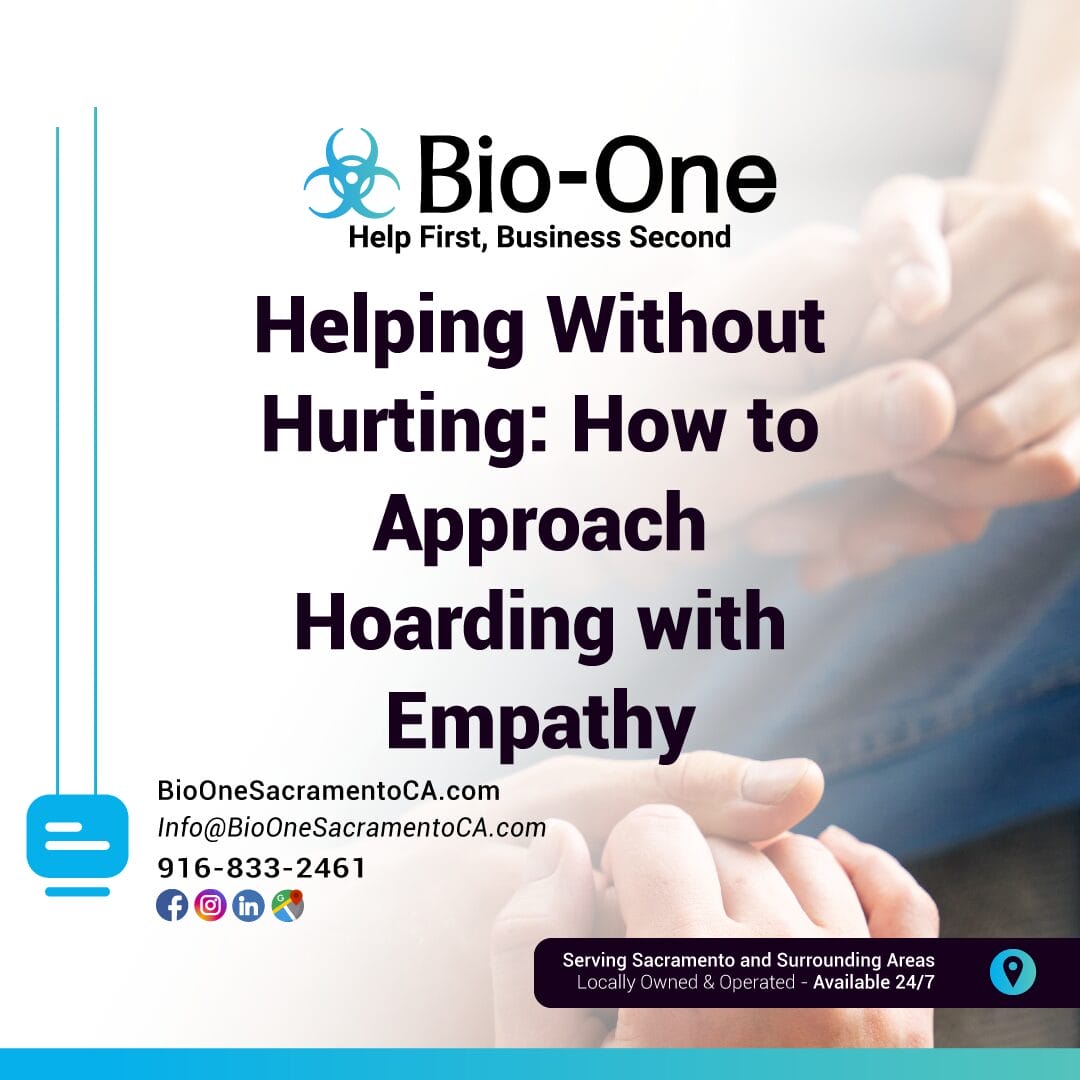
Hoarding can be a challenging topic to discuss, especially when it involves someone you care about. Watching a loved one struggle with hoarding can leave you feeling helpless, overwhelmed, and uncertain about what to do. But approaching the situation with understanding, patience, and compassion is key to providing effective hoarding support.
This guide will help you better understand hoarding, offer strategies for starting difficult conversations, and highlight steps you can take to offer meaningful help without causing harm.
Hoarding is more than keeping too many things; it’s a complex mental health condition that can affect a person’s daily life, relationships, and well-being. It’s often linked to anxiety, depression, or trauma, making it difficult for the individual to part with possessions, no matter their condition or value.
The living conditions created by hoarding often pose safety risks. Clutter can lead to falls, fire hazards, and even biohazards, depending on the severity of the situation. These dangers highlight the importance of addressing hoarding in a supportive and proactive way.
Before initiating a conversation, take time to learn about hoarding. Understanding what your loved one is going through will help you approach them with empathy and avoid judgment. The International OCD Foundation provides valuable resources on hoarding disorder, helping you see it from their perspective. This foundational knowledge can build a bridge of understanding, an essential tool for effective communication.
Consider reading expert articles or consulting with local professionals like therapists who specialize in hoarding behaviors. By learning more, you’ll not only feel better equipped but also show your loved one that your intention comes from a place of care, not criticism.
Starting a conversation with someone who hoards can feel intimidating. The key is to foster trust and safety. Here are a few tips to guide you:
Once you’ve opened the conversation, explore ways to offer support. Remember, the goal is to help them feel empowered, not forced. Here are effective strategies to explore:
Supporting a loved one in seeking professional guidance can be a game-changer. A therapist or counselor who specializes in hoarding can provide tailored coping strategies and solutions. You can help by finding local mental health professionals or directing them to resources like SAMHSA’s Behavioral Health Treatment Locator.
Severe hoarding situations often require expert assistance. Reputable cleanup services like Bio-One Sacramento specialize in compassionate and discreet hoarding cleanup. They prioritize respect for the individual while ensuring the space becomes safe and livable again. Sharing this type of resource can relieve some burden and show your loved one that they’re not alone in this process.
Instead of tackling the entire issue at once, focus on incremental progress. For example, suggest sorting through one small area together. This makes the task less overwhelming and builds a sense of accomplishment. Tools like checklists or decluttering apps can guide the process without feeling overbearing.
Change doesn’t happen overnight, especially when dealing with deeply ingrained habits tied to emotional struggles. It’s crucial to practice patience and continue showing empathy, even if progress feels slow. Celebrate small victories along the way and reassure your loved one that you’re there for them unconditionally.
If you find yourself feeling frustrated or overwhelmed, don’t hesitate to seek support for yourself. Talking to a therapist or joining a support group for friends and family of individuals with hoarding disorder can provide valuable encouragement and advice. It’s important to prioritize your well-being as you support your loved one.
By approaching hoarding with empathy and understanding, you can help your loved one move toward a healthier and more secure life. While the process may not be easy, your willingness to offer compassionate hoarding support can make all the difference in their path to recovery.
For more information on professional hoarding cleanup services, visit Bio-One Sacramento. Additionally, resources like the International OCD Foundation offer valuable insights into hoarding disorder and practical guidance for families navigating these challenges.
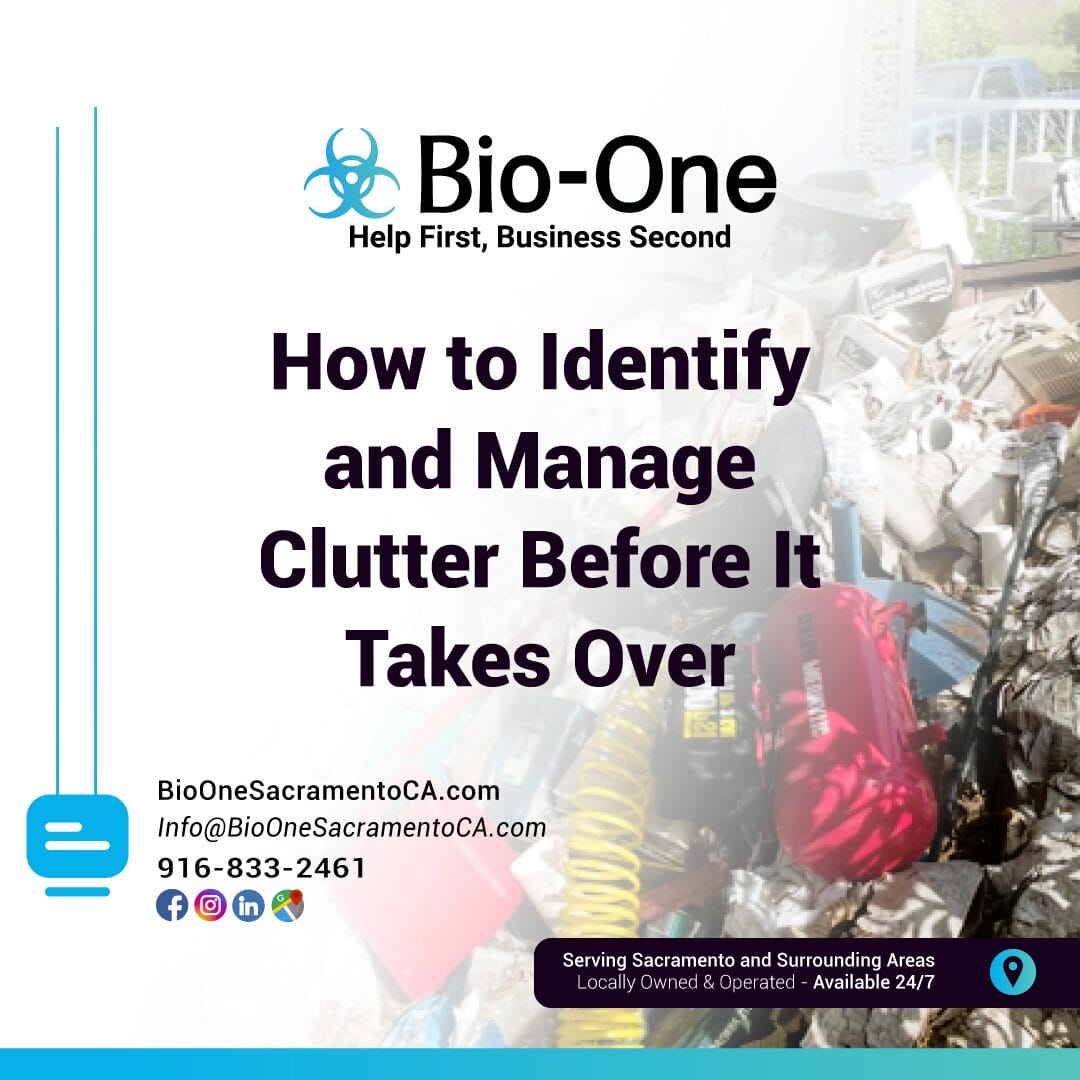
Clutter has a sneaky way of piling up when we’re not paying attention. One day, you’re organizing your belongings, and the next, you can’t find your car keys under a mountain of unopened mail. The line between a full yet functional home and overwhelming disorganization can blur quickly. That’s why understanding clutter management is essential to maintaining a comfortable, stress-free environment.
But don’t worry—you’re not alone in facing down the piles. At Bio-One of Sacramento, our expert team specializes in restoring order, even in the most challenging hoarding situations. Here’s how you can spot the trouble before it grows and keep your living spaces under control.
Clutter doesn’t always look the same in every home, but there are some clear signals that it’s starting to take over. Here are a few red flags to watch for:
Once you've identified the issue, the next move is action. With the right approach, you can stay on top of clutter before it becomes a bigger problem. Here's how:
Grab three boxes and label them "Keep," "Donate," and "Trash." Go through your belongings one area at a time, placing each item into a category. Stick to this system; it’s your first step to reclaiming order.
Once you’ve decided what to keep, assign a specific place for it. Storage bins, labels, and shelving can help ensure everything has its own spot. It’s harder for clutter to build up when everything lives where it should.
Just like cleaning, clutter management is easier in small doses. Set aside 15 minutes a day or schedule weekly decluttering sessions to prevent things from piling back up.
For every new item you bring into your home, remove an old one. This simple habit helps balance what you own and stops clutter from creeping back in.
Sometimes, clutter issues can spiral into hoarding situations. If you’re feeling overwhelmed, there’s no shame in asking for support.
At Bio-One of Sacramento, we understand that clutter doesn’t just pile up physically. It can also take a toll on your peace of mind. If you’re faced with a situation that feels too overwhelming to handle alone, know that we’re here to help.
Our expert team has the experience, compassion, and tools required to tackle everything from basic clutter management to complex hoarding cleanups. No matter the situation, our goal is to restore your space and your peace of mind. With our assistance, you can move forward into a cleaner, healthier environment.
Clutter doesn’t have to control your life. By taking small steps or enlisting professional help, you can reclaim your home and safeguard your wellbeing. Remember, your environment has a direct impact on your mental and emotional state. A well-organized space creates room for clarity and calm.
If you’re ready to tackle clutter for good, reach out to Bio-One of Sacramento. Our caring and capable team is ready to support you every step of the way.
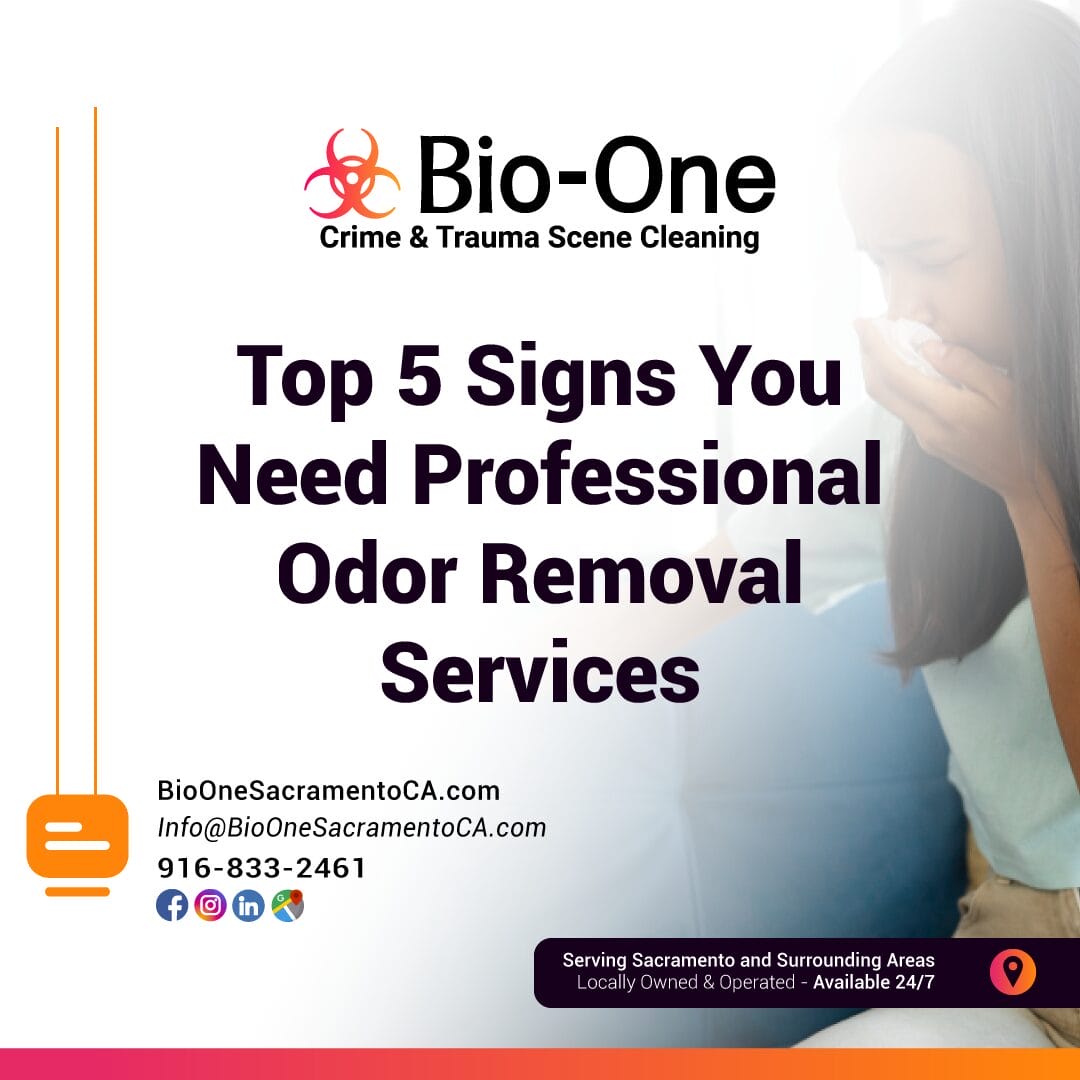
Unpleasant odors can affect your living or working environment far more than you might think. They can linger, disrupt comfort, and even pose health risks. While temporary fixes like candles or air fresheners might mask smells, some odors demand expert attention. Here are the top five signs you need professional odor removal services, and why Bio-One of Sacramento is your trusted partner for tackling these issues effectively.
If you’ve cleaned every surface, opened every window, and still can’t shake an unpleasant smell, it’s likely time to call in professionals. Persistent odors often stem from hidden issues like pet accidents beneath floorboards, mold growth inside walls, or deeply embedded smells in carpets. Professional odor removal services are equipped with specialized tools and techniques to locate and eliminate the source rather than covering it up. At Bio-One of Sacramento, we excel in finding the root of the problem and neutralizing it completely.
Have you tried every DIY remedy in the book, only to find the smell creeping back? Odors caused by smoke, chemical spills, or biological contaminants are notoriously difficult to remove with over-the-counter solutions. DIY methods can sometimes even worsen the problem by spreading odor particles rather than removing them. Bio-One of Sacramento uses advanced equipment and industry-approved methods to ensure even the most stubborn smells are permanently eliminated, saving you time and frustration.
Certain odors aren’t just unpleasant; they can be harmful. Moldy smells might indicate toxic mold spores in the air, while a musty scent might point to water damage leading to bacteria and fungi growth. Foul odors from things like pet waste or decomposing materials can harbor harmful pathogens. If you or your family experience headaches, respiratory issues, or other health problems linked to an odor, getting professional odor removal is imperative. Bio-One of Sacramento specializes in handling these hazardous situations safely and effectively.
Some situations simply call for an expert. For instance, smoke odors after a fire, sewage backups, or decomposition odors in certain environments can linger for years if not properly addressed. These situations often require industrial-grade tools and robust cleaning protocols that professionals like Bio-One of Sacramento can provide. Our team is certified and trained to handle even the toughest odor removal jobs with care and efficiency.
If you’re selling or renting out a property, lingering odors can deter potential buyers or tenants. Similarly, a smelly storefront or office can make a poor impression on clients. Professional odor removal ensures your space smells clean and inviting, which can significantly boost its appeal. Bio-One of Sacramento works discreetly and promptly to help you restore confidence in your property, ensuring a pleasant environment for guests, clients, or potential buyers.
At Bio-One of Sacramento, we understand that odor issues can be overwhelming and even embarrassing. That’s why we approach every job with sensitivity, expertise, and a focus on solving the problem for good. Our team uses state-of-the-art equipment, eco-friendly cleaning solutions, and proven techniques to eliminate even the toughest odors at their source.
Whether you’re dealing with an odor caused by everyday life, a disaster, or specific contamination, we’re here to help. Don’t wait for the smell to grow worse or cause more problems. Trust Bio-One of Sacramento for top-tier, professional odor removal services tailored to your needs!
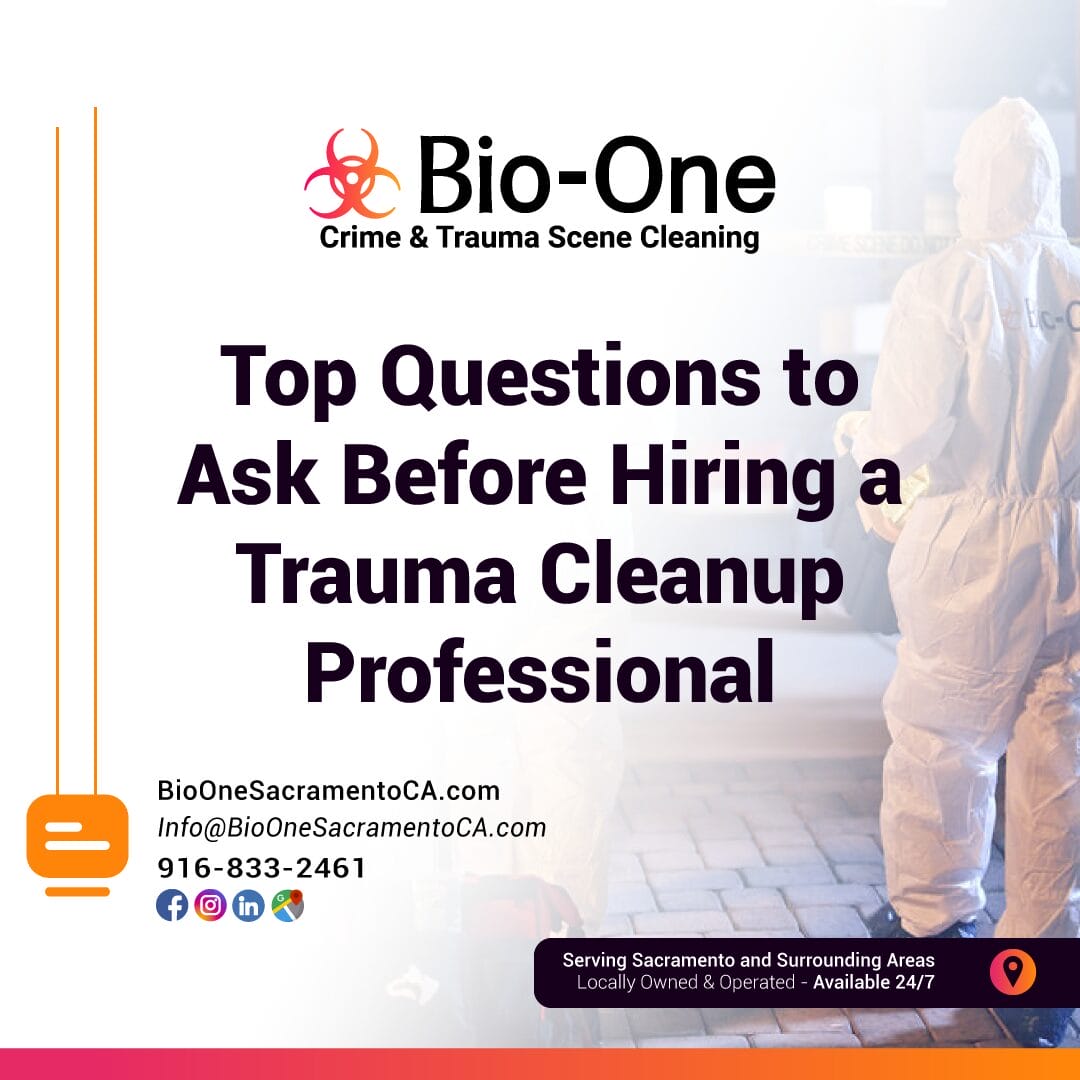
Dealing with a trauma situation that requires professional cleanup is not only emotionally overwhelming but often comes with unique challenges. Ensuring the cleanup is done safely, professionally, and with care is crucial for restoring your space and providing peace of mind. However, not all cleanup services offer the same level of expertise, compassion, or attention to detail. To help you make an informed decision, here are the top questions you should ask before hiring a trauma cleanup professional.
Trauma cleanup is a highly specialized field that requires proper licensing and certification. A reputable company should have proof of certification from organizations like the Occupational Safety and Health Administration (OSHA) or similar bodies that govern biohazard handling. Ask if their technicians are trained in bloodborne pathogen handling, biohazard waste disposal, and other safety guidelines. This ensures they’re equipped to manage hazardous materials correctly.
Experience matters in trauma cleanup. Companies with years of experience in the field are more likely to have encountered a range of situations and know how to address them effectively. Whether the cleanup involves blood, bodily fluids, unattended deaths, or hoarding situations, an experienced company brings not only technical expertise but also an understanding of the emotional toll these incidents can have.
Ask how long the company has been operating, as well as what types of scenarios they’ve handled. Specific examples can give you confidence in their capabilities.
Safety is paramount in trauma cleanup to protect both the professionals and the property’s occupants. A good company should adhere to strict safety protocols, including the use of personal protective equipment (PPE), proper containment methods, and medical-grade disinfectants. Additionally, they should ensure thorough decontamination to prevent the spread of disease or residual contamination.
Trauma situations are often emotionally charged and deeply personal. The last thing you want during such a time is to feel judged or scrutinized. Look for professionals who prioritize compassion and discretion. A company like Bio-One of Sacramento, for instance, uses unmarked vehicles to maintain privacy and approaches every scene with sensitivity and respect.
“How does your team handle emotionally sensitive situations, and what steps do you take to ensure my privacy is protected?”
Trauma cleanup services can be costly depending on the severity of the situation. Many reputable companies work directly with insurance providers to help ease the financial burden. Confirm whether the company can assist with filing insurance claims and if they have experience navigating the paperwork involved.
Modern trauma cleanup requires advanced tools and techniques to ensure thorough decontamination. Ask about the types of equipment the company uses. This might include ozone generators, air scrubbers, or hospital-grade disinfectants. If a company uses outdated or subpar tools, the cleanup may not be as effective as it should be.
Word of mouth and online reviews are powerful tools for gauging the quality of a service provider. A reputable company will often have testimonials or reviews from satisfied customers. You can also ask if they’re willing to provide references for additional reassurance.
Look for feedback that highlights professionalism, compassion, and effectiveness. For Bio-One of Sacramento, client reviews emphasize how the team goes above and beyond to help families during difficult times.
Trauma cleanup is often urgent. Time-sensitive situations, including suicides, crime scenes, and decomposition scenarios, can pose health risks if left unaddressed. Ask the company how soon they can arrive on-site and whether they offer 24/7 availability.
A quick response minimizes further damage to the property and helps you start moving forward sooner.
Trauma cleanup might require more than just cleaning. It could involve odor removal, remediation, or even working in collaboration with other professionals like coroners or property managers. Make sure the company you hire offers a comprehensive range of services tailored to your specific needs.
Trustworthy trauma cleanup professionals take pride in their work and deliver results that leave clients satisfied. Ask if the company offers a satisfaction guarantee. This reflects confidence in their services and reassures you that they won’t leave the job until it meets their standards.
At Bio-One of Sacramento, we understand that trauma cleanup is about more than removing contaminants; it’s about helping individuals and families move forward with dignity and care. Here’s what sets us apart:
Choosing the right trauma cleanup professional can make all the difference during a difficult time. By asking the right questions and ensuring the company you hire has the qualifications, experience, and compassion needed for the job, you’re taking the first step toward restoring your space.
If you find yourself needing trauma cleanup services, don’t hesitate to reach out to Bio-One of Sacramento. We’re here to help, 24/7, with professionalism and care.
---
Contact Bio-One of Sacramento Today
Call us at 916-833-2461 or visit our website to learn more about our trauma cleanup services. Assistance is just a call away.